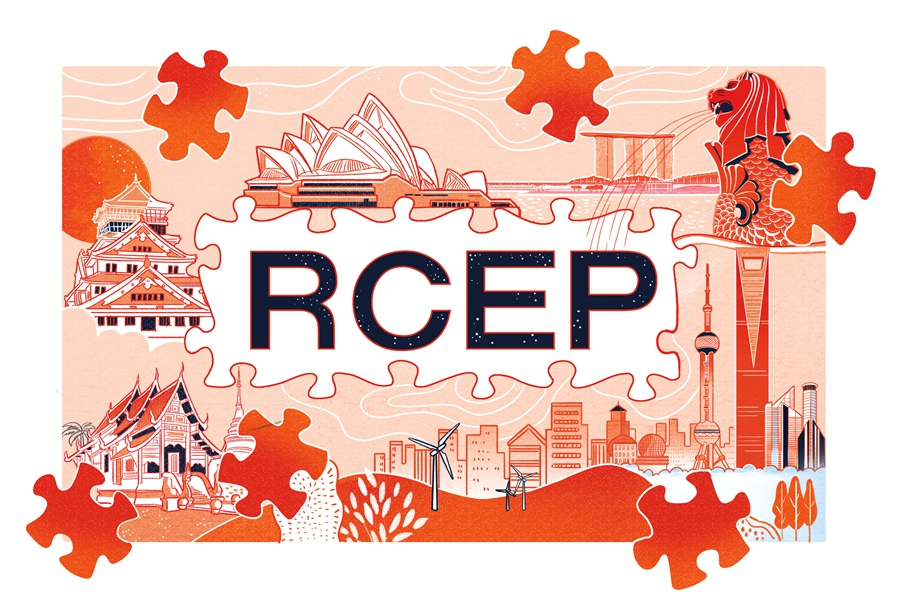Signing of RCEP on track despite disruption
By Iram Khan | chinadaily.com.cn | Updated: 2020-03-27 10:09

With China now in the final stages of defeating COVID-19, domestic commercial activities are picking again and the country's next priority seems to be bringing international trade back into full gear. The Ministry of Commerce has, at this crucial time, announced that signing of the Regional Comprehensive Economic Partnership (RCEP) is expected to take place by the end of this year.
RCEP is an agreement between 10 states of the Association of Southeast Asian Nations (ASEAN) and its Free Trade Agreement (FTA) partners that include China, Japan, South Korea, Australia, and New Zealand. Proposed in 2012, it aims to boost trade in the eastern hemisphere through liberalized policies and enhanced capabilities of member states. On coming into effect, RCEP will be one of the largest such agreements in terms of the size of its economy and the population it covers.
Negotiations have been on-going for almost seven years and have revolved around interests and concerns of stakeholders and how they can be converged to a single direction. The stage-wise process includes defining technicalities, carrying out legal reviews and finally signing of the agreement. Presently, all parties are formalizing texts which will be put up for final consideration before the planned ceremony.
China is the linchpin in making this concept a reality. Being the engine of global industry, it is attempting to enhance regional trade and is offering gains from its monumental growth to its neighbors. Its continuous push toward inclusiveness has brought it as the facilitator in materializing the RCEP. Just as it has recovered from the coronavirus outbreak, other nations will also start to recuperate and resume their overseas commerce under this umbrella.
RCEP is one of China's several international level efforts to promote free trade. The country is pursuing such arrangements not only eastwardly but also in the Middle East and Europe. With their consolidation, even the Belt and Road countries will be able to utilize the expansive network.
The agreement will build upon the success of the FTA between China and ASEAN that is in place since 2002. Cooperation among the two has been so productive that ASEAN crossed the United States last year as China's second-largest trade partner.
RCEP will likewise increase the transaction volume among participants by improving their access to diversified markets. As the overall investment environment will strengthen, it will lift the region's development potential and transfer the benefits to people.
In addition to that, the envisioned integration will introduce new supply chains, connecting manufacturing bases with more consumers, and deepen the growing ties in East Asia. This kind of interdependence will reduce the likelihood of political friction that is often the result of external interference.
Free trade, the basic idea behind this collaboration will lower barriers and bring consumer prices down in a region that is rich in resources but struggles to cope with the low buying power of many of its citizens. As local firms will compete with foreign peers, they will be incentivized to take the path of innovation in providing high-quality products at low prices.
A wave of protectionism had been detrimental to global growth during the past two years. It was hampering economies already under pressure from factors like aging populations, rising wages, and resources' depletion. RCEP will nullify the effects of protectionism as engagement under the pact will inherently entail international cooperation.
China itself has been a supporter of multilateralism for concurrent progress of the developing and the developed world. Its opening up process falls exactly in line with the principles of the RCEP as the government has, over time, introduced measures to attract capital and bolster investor confidence.
Once the agreement is signed, it will further reduce bottlenecks for foreign investment in participating countries. The result will be a stable environment with thriving multinational exchanges. Moreover, it will counter uncertainty and add resilience to economies.
While the US has pushed for its own regional trade deal, named Comprehensive and Progressive Agreement for Trans-Pacific Partnership (CPTPP), it fell short of providing a reliable opportunity when President Donald Trump withdrew from the Trans-Pacific Partnership (TPP) right after coming to office. Though in an encouraging sign for free trade proponents, seven nations are still members of both the RCEP and the CPTPP.
After the disruption caused by the coronavirus epidemic, RCEP becomes even more important. Reigniting the world's transport industry and reinstating consumer confidence would require a stimulus that is offered by this accord. It is a golden chance for the new bloc to emerge as a strong unified force in pursuit of a shared future.
The author is a Pakistan-based commentator on international and commercial affairs.
The opinions expressed here are those of the writer and do not necessarily represent the views of China Daily and China Daily website.
























